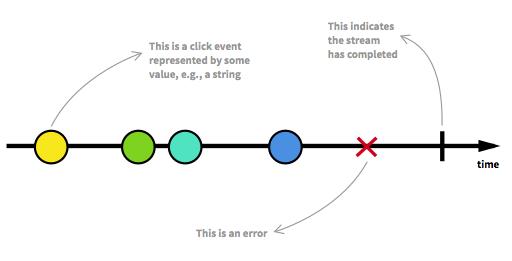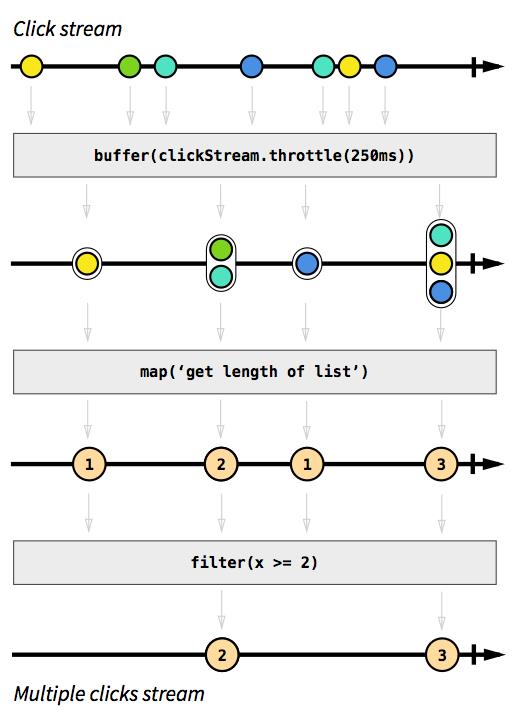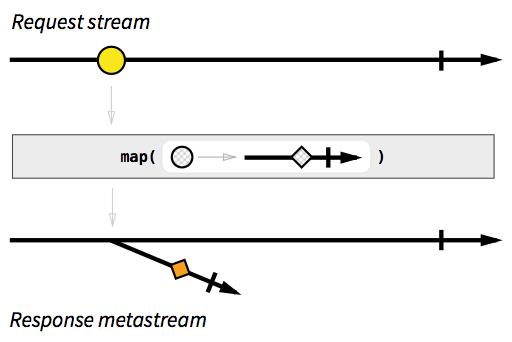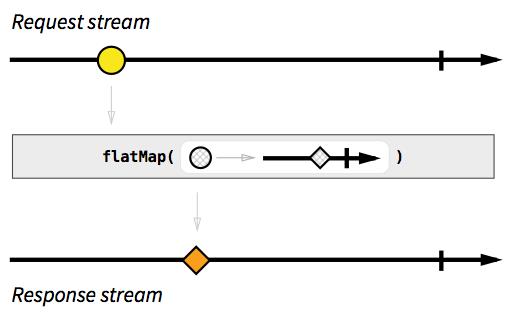react programming
Posted lucky_star_star
tags:
篇首语:本文由小常识网(cha138.com)小编为大家整理,主要介绍了react programming相关的知识,希望对你有一定的参考价值。
So you‘re curious in learning this new thing called Reactive Programming, particularly its variant comprising of Rx, Bacon.js, RAC, and others.
相信你们在学习响应式编程这个新技术的时候都会充满了好奇,特别是它的一些变体,包括Rx系列、Bacon.js、RAC和其他的一些变体。
Learning it is hard, even harder by the lack of good material. When I started, I tried looking for tutorials. I found only a handful of practical guides, but they just scratched the surface and never tackled the challenge of building the whole architecture around it. Library documentations often don‘t help when you‘re trying to understand some function. I mean, honestly, look at this:
Rx.Observable.prototype.flatMapLatest(selector, [thisArg])
Projects each element of an observable sequence into a new sequence of observable sequences by incorporating the element‘s index and then transforms an observable sequence of observable sequences into an observable sequence producing values only from the most recent observable sequence.
Holy cow.
学习响应式编程是个困难的过程,尤其是在当前缺乏优秀资料的前提下。起初,我试图寻找一些教程,却只找到了少量的实践指南,而且它们讲的都非常浅显(scratched the surface),从来没人接受围绕着响应式编程建立一个完整知识体系的挑战。而官方文档通常也并不能完全地帮助你理解某些函数,它们通常看起来很绕,不信请看这里:
Rx.Observable.prototype.flatMapLatest(selector, [thisArg])
根据元素下标,将可观察序列中每个元素一一映射到一个新的可观察序列当中,然后...%…………%&¥#@@……&**(晕了)
天呐,这简直太绕了!
I‘ve read two books, one just painted the big picture, while the other dived into how to use the Reactive library. I ended up learning Reactive Programming the hard way: figuring it out while building with it. At my work in Futurice I got to use it in a real project, and had the support of some colleagues when I ran into troubles.
The hardest part of the learning journey is thinking in Reactive. It‘s a lot about letting go of old imperative and stateful habits of typical programming, and forcing your brain to work in a different paradigm. I haven‘t found any guide on the internet in this aspect, and I think the world deserves a practical tutorial on how to think in Reactive, so that you can get started. Library documentation can light your way after that. I hope this helps you.
我读过两本相关的书,一本只是在给你描绘响应式编程的伟大景象,而另一本却只是深入到如何使用响应式库而已。我在不断的构建(building)中把响应式编程了解的透彻了一些,最后以这种艰难的方式学完了响应式编程。在我工作公司的一个真实项目中我会用到它,当我遇到问题时,还可以得到同事的支持。
学习过程中最难的部分是如何以响应式的方式来思考,更多的意味着要摒弃那些老旧的命令式和状态式的典型编程习惯,并且强迫自己的大脑以不同的范式来运作。我还没有在网络上找到任何一个教程是从这个层面来剖析的,我觉得这个世界非常值得拥有一个优秀的实践教程来教你如何以响应式编程的方式来思考,方便引导你开始学习响应式编程。然后看各种库文档才可以给你更多的指引。希望这篇文章能够帮助你快速地进入响应式编程的世界。
"What is Reactive Programming?"
There are plenty of bad explanations and definitions out there on the internet. Wikipedia is too generic and theoretical as usual.Stackoverflow‘s canonical answer is obviously not suitable for newcomers. Reactive Manifesto sounds like the kind of thing you show to your project manager or the businessmen at your company. Microsoft‘s Rx terminology "Rx = Observables + LINQ + Schedulers" is so heavy and Microsoftish that most of us are left confused. Terms like "reactive" and "propagation of change" don‘t convey anything specifically different to what your typical MV* and favorite language already does. Of course my framework views react to the models. Of course change is propagated. If it wouldn‘t, nothing would be rendered.
So let‘s cut the bullshit.
"什是响应式编程?"
网络上有一大堆糟糕的解释和定义,Wikipedia上通常都是些非常笼统和理论性的解释,Stackoverflow上的一些规范的回答显然也不适合新手来参考,Reactive Manifesto看起来也只像是拿给你的PM或者老板看的东西,微软的Rx术语"Rx = Observables + LINQ + Schedulers" 也显得太过沉重,而且充满了太多微软式的东西,反而给我们留下了更多的疑惑。相对于你使用的MV*框架以及你钟爱的编程语言,"Reactive"和"Propagation of change"这样的术语并没有传达任何有意义的概念。当然,我的view框架能够从model做出反应,我的改变当然也会传播,如果没有这些,我的界面根本就没有东西可渲染(译者:最后一句旨在说明微软的术语化的东西都非常老套、非常教科书化)。
所以,不要再扯这些废话了。
Reactive programming is programming with asynchronous data streams.
In a way, this isn‘t anything new. Event buses or your typical click events are really an asynchronous event stream, on which you can observe and do some side effects. Reactive is that idea on steroids. You are able to create data streams of anything, not just from click and hover events. Streams are cheap and ubiquitous, anything can be a stream: variables, user inputs, properties, caches, data structures, etc. For example, imagine your Twitter feed would be a data stream in the same fashion that click events are. You can listen to that stream and react accordingly.
响应式编程就是与异步数据流交互的编程范式
一方面,这已经不是什么新事物了。事件总线(Event Buses)或一些典型的点击事件本质上就是一个异步事件流(asynchronous event stream),这样你就可以观察它的变化并使其做出一些反应(产生一些效果(do some side effects))。响应式是这样的一个思路:除了点击(click)和悬停(hover)的事件外,你可以给任何事物创建数据流。数据流无处不在(Streams are cheap and ubiquitous),任何东西都可以成为一个数据流,例如变量、用户输入、属性、缓存、数据结构等等。举个栗子,你可以把你的微博订阅功能想象成跟点击事件一样的数据流,你可以监听这样的数据流,并做出相应的反应。
On top of that, you are given an amazing toolbox of functions to combine, create and filter any of those streams.That‘s where the "functional" magic kicks in. A stream can be used as an input to another one. Even multiple streams can be used as inputs to another stream. You can merge two streams. You can filter a stream to get another one that has only those events you are interested in. You can map data values from one stream to another new one.
If streams are so central to Reactive, let‘s take a careful look at them, starting with our familiar "clicks on a button" event stream.
A stream is a sequence of ongoing events ordered in time. It can emit three different things: a value (of some type), an error, or a "completed" signal. Consider that the "completed" takes place, for instance, when the current window or view containing that button is closed.
We capture these emitted events only asynchronously, by defining a function that will execute when a value is emitted, another function when an error is emitted, and another function when ‘completed‘ is emitted. Sometimes these last two can be omitted and you can just focus on defining the function for values. The "listening" to the stream is called subscribing. The functions we are defining are observers. The stream is the subject (or "observable") being observed. This is precisely the Observer Design Pattern.
An alternative way of drawing that diagram is with ASCII, which we will use in some parts of this tutorial:
--a---b-c---d---X---|->
a, b, c, d are emitted values
X is an error
| is the ‘completed‘ signal
---> is the timeline
Since this feels so familiar already, and I don‘t want you to get bored, let‘s do something new: we are going to create new click event streams transformed out of the original click event stream.
最重要的是,你会拥有一些令人惊艳的函数去结合(combine)、创建(create)和过滤(filter)任何一组数据流。 这就是"函数式编程"的魔力所在。一个数据流可以作为另一个数据流的输入,甚至多个数据流也可以作为另一个数据流的输入。你可以合并(merge)两个数据流,也可以过滤(filter)一个数据流得到另一个只包含你感兴趣的事件的数据流,还可以映射(map)一个数据流的值到一个新的数据流里。
如果数据流对于响应式是如此的核心(so central to Reactive),那就让我们来仔细的看看它们,先从我们熟悉的"点击一个按钮"的事件流开始
一个数据流是一个按时间排序的即将发生的事件(Ongoing events ordered in time)的序列。如上图,它可以发出3种不同的事件(上一句已经把它们叫做事件):一个某种类型的值事件,一个错误事件和一个完成事件。当一个完成事件发生时,在某些情况下,我们可能会做这样的操作:关闭包含那个按钮的窗口或者视图组件。
我们只能异步的的去捕捉这些被发出的事件,这样我们就可以在发出一个值事件时执行一个函数,发出错误事件时执行一个函数,发出完成事件时执行另一个函数。有时候你可以忽略后两个事件,只需聚焦于如何定义和设计在发出值事件时要执行的函数,监听这个事件流的过程叫做订阅,我们定义的函数叫做观察者,而事件流就可以叫做被观察的主题(或者叫被观察者)。你应该察觉到了,对的,它就是观察者模式。
上面的示意图我们也可以用ASCII码的形式重新画一遍,请注意,下面的部分教程中我们会继续使用这幅图:
--a---b-c---d---X---|->
a, b, c, d 是值事件
X 是错误事件
| 是完成事件
---> 是时间线(轴)
现在你对响应式编程事件流应该非常熟悉了,为了不让你感到无聊,让我们来做一些新的尝试吧:我们将创建一个由原始点击事件流演变而来的一种新的点击事件流。
First, let‘s make a counter stream that indicates how many times a button was clicked. In common Reactive libraries, each stream has many functions attached to it, such as map, filter, scan, etc. When you call one of these functions, such asclickStream.map(f), it returns a new stream based on the click stream. It does not modify the original click stream in any way. This is a property called immutability, and it goes together with Reactive streams just like pancakes are good with syrup. That allows us to chain functions like clickStream.map(f).scan(g):
clickStream: ---c----c--c----c------c-->
vvvvv map(c becomes 1) vvvv
---1----1--1----1------1-->
vvvvvvvvv scan(+) vvvvvvvvv
counterStream: ---1----2--3----4------5-->
The map(f) function replaces (into the new stream) each emitted value according to a function f you provide. In our case, we mapped to the number 1 on each click. The scan(g) function aggregates all previous values on the stream, producing value x = g(accumulated, current), where g was simply the add function in this example. Then, counterStream emits the total number of clicks whenever a click happens.
首先,让我们来创建一个记录按钮点击次数的事件流。在常用的响应式库中,每个事件流都会附有一些函数,例如 map,filter, scan等,当你调用这其中的一个方法时,比如clickStream.map(f),它会返回基于点击事件流的一个新事件流。它不会对原来的点击事件流做任何的修改。这种特性叫做不可变性(immutability),而且它可以和响应式事件流搭配在一起使用,就像豆浆和油条一样完美的搭配。这样我们可以用链式函数的方式来调用,例如:clickStream.map(f).scan(g):
clickStream: ---c----c--c----c------c-->
vvvvv map(c becomes 1) vvvv
---1----1--1----1------1-->
vvvvvvvvv scan(+) vvvvvvvvv
counterStream: ---1----2--3----4------5-->
map(f)函数会根据你提供的f函数把原事件流中每一个返回值分别映射到新的事件流中。在上图的例子中,我们把每一次点击事件都映射成数字1,scan(g)函数则把之前映射的值聚集起来,然后根据x = g(accumulated, current)算法来作相应的处理,而本例的g函数其实就是简单的加法函数。然后,当一个点击事件发生时,counterStream函数则上报当前点击事件总数。
To show the real power of Reactive, let‘s just say that you want to have a stream of "double click" events. To make it even more interesting, let‘s say we want the new stream to consider triple clicks as double clicks, or in general, multiple clicks (two or more). Take a deep breath and imagine how you would do that in a traditional imperative and stateful fashion. I bet it sounds fairly nasty and involves some variables to keep state and some fiddling with time intervals.
Well, in Reactive it‘s pretty simple. In fact, the logic is just 4 lines of code. But let‘s ignore code for now. Thinking in diagrams is the best way to understand and build streams, whether you‘re a beginner or an expert.
Grey boxes are functions transforming one stream into another. First we accumulate clicks in lists, whenever 250 milliseconds of "event silence" has happened (that‘s what buffer(stream.throttle(250ms)) does, in a nutshell. Don‘t worry about understanding the details at this point, we are just demoing Reactive for now). The result is a stream of lists, from which we applymap() to map each list to an integer matching the length of that list. Finally, we ignore 1 integers using the filter(x >= 2)function. That‘s it: 3 operations to produce our intended stream. We can then subscribe ("listen") to it to react accordingly how we wish.
I hope you enjoy the beauty of this approach. This example is just the tip of the iceberg: you can apply the same operations on different kinds of streams, for instance, on a stream of API responses; on the other hand, there are many other functions available.
为了展示响应式编程真正的魅力,我们假设你有一个"双击"事件流,为了让它更有趣,我们假设这个事件流同时处理"三次点击"或者"多次点击"事件,然后深吸一口气想想如何用传统的命令式和状态式的方式来处理,我敢打赌,这么做会相当的讨厌,其中还要涉及到一些变量来保存状态,并且还得做一些时间间隔的调整。
而用响应式编程的方式处理会非常的简洁,实际上,逻辑处理部分只需要四行代码。但是,当前阶段让我们现忽略代码的部分,无论你是新手还是专家,看着图表思考来理解和建立事件流将是一个非常棒的方法。
图中,灰色盒子表示将上面的事件流转换下面的事件流的函数过程,首先根据250毫秒的间隔时间(event silence, 译者:无事件发生的时间段,上一个事件发生到下一个事件发生的间隔时间)把点击事件流一段一隔开,再将每一段的一个或多个点击事件添加到列表中(这就是这个函数:buffer(stream.throttle(250ms))所做的事情,当前我们先不要急着去理解细节,我们只需专注响应式的部分先)。现在我们得到的是多个含有事件流的列表,然后我们使用了map()中的函数来算出每一个列表长度的整数数值映射到下一个事件流当中。最后我们使用了过滤filter(x >= 2) 函数忽略掉了小于1 的整数。就这样,我们用了3步操作生成了我们想要的事件流,接下来,我们就可以订阅("监听")这个事件并作出我们想要的操作了。
我希望你能感受到这个示例的优雅之处。当然了,这个示例也只是响应式编程魔力的冰山一角而已,你同样可以将这3步操作应用到不同种类的事件流中去,例如,一串API响应的事件流。另一方面,你还有非常多的函数可以使用。
"Why should I consider adopting RP?"
Reactive Programming raises the level of abstraction of your code so you can focus on the interdependence of events that define the business logic, rather than having to constantly fiddle with a large amount of implementation details. Code in RP will likely be more concise.
The benefit is more evident in modern webapps and mobile apps that are highly interactive with a multitude of UI events related to data events. 10 years ago, interaction with web pages was basically about submitting a long form to the backend and performing simple rendering to the frontend. Apps have evolved to be more real-time: modifying a single form field can automatically trigger a save to the backend, "likes" to some content can be reflected in real time to other connected users, and so forth.
Apps nowadays have an abundancy of real-time events of every kind that enable a highly interactive experience to the user. We need tools for properly dealing with that, and Reactive Programming is an answer.
"我为什么要采用响应式编程?"
响应式编程可以提高你的代码抽象级别,好让你可以专注于定义与事件相互依存的业务逻辑,而不是把大量精力放在实现细节上,使用响应式编程会让你的代码变得更加简洁。
特别对于现在流行的webapps和mobile apps,这些频繁与数据事件相关的大量UI事件交互的程序,好处就更加的明显了。十年前,web页面的交互是通过提交一个很长的表单数据到后端,然后再做一些简单的前端渲染操作。而现在的Apps则演变的更具有实时性:仅仅修改一个单独的表单域就能自动的触发保存到后端的代码,就像某个用户对一些内容点了赞,就能够实时反映到其他已连接的用户一样,等等。
当今的Apps都含有丰富的实时事件来保证一个高效的用户体验,我们就需要采用一个合适的工具来处理,那么响应式编程就正好是我们想要的答案。
Thinking in RP, with examples
Let‘s dive into the real stuff. A real-world example with a step-by-step guide on how to think in RP. No synthetic examples, no half-explained concepts. By the end of this tutorial we will have produced real functioning code, while knowing why we did each thing.
I picked JavaScript and RxJS as the tools for this, for a reason: javascript is the most familiar language out there at the moment, and the Rx* library family is widely available for many languages and platforms (.NET, Java, Scala, Clojure, JavaScript,Ruby, Python, C++, Objective-C/Cocoa, Groovy, etc). So whatever your tools are, you can concretely benefit by following this tutorial.
以响应式编程方式思考的例子
让我们深入到一些真实的例子,一个能够一步一步教你如何以响应式编程的方式思考的例子,没有虚构的示例,没有一知半解的概念。在这个教程的末尾我们将产生一些真实的函数代码,并能够知晓每一步为什么那样做的原因(知其然,知其所以然)。
我选了JavaScript和RxJS来作为本教程的编程语言,原因是:JavaScript是目前最多人熟悉的语言,而Rx系列的库对于很多语言和平台的运用是非常广泛的,例如(.NET, Java, Scala, Clojure, JavaScript, Ruby, Python, C++, Objective-C/Cocoa, Groovy等等。所以,无论你用的是什么语言、库、工具,你都能从下面这个教程中学到东西(从中受益)。
Implementing a "Who to follow" suggestions box
In Twitter there is this UI element that suggests other accounts you could follow:
We are going to focus on imitating its core features, which are:
- On startup, load accounts data from the API and display 3 suggestions
- On clicking "Refresh", load 3 other account suggestions into the 3 rows
- On click ‘x‘ button on an account row, clear only that current account and display another
- Each row displays the account‘s avatar and links to their page
We can leave out the other features and buttons because they are minor. And, instead of Twitter, which recently closed its API to the unauthorized public, let‘s build that UI for following people on Github. There‘s a Github API for getting users.
The complete code for this is ready at http://jsfiddle.net/staltz/8jFJH/48/ in case you want to take a peak already.
实现一个推荐关注(Who to follow)的功能
在Twitter里有一个UI元素向你推荐你可以关注的用户,如下图:
我们将聚焦于模仿它的主要功能,它们是:
- 开始阶段,从API加载推荐关注的用户账户数据,然后显示三个推荐用户
- 点击刷新,加载另外三个推荐用户到当前的三行中显示
- 点击每一行的推荐用户上的‘x‘按钮,清楚当前被点击的用户,并显示新的一个用户到当前行
- 每一行显示一个用户的头像并且在点击之后可以链接到他们的主页。
我们可以先不管其他的功能和按钮,因为它们是次要的。因为Twitter最近关闭了未经授权的公共API调用,我们将用Github获取用户的API代替,并且以此来构建我们的UI。
如果你想先看一下最终效果,这里有完成后的代码。
Request and response
How do you approach this problem with Rx? Well, to start with, (almost) everything can be a stream. That‘s the Rx mantra. Let‘s start with the easiest feature: "on startup, load 3 accounts data from the API". There is nothing special here, this is simply about (1) doing a request, (2) getting a response, (3) rendering the response. So let‘s go ahead and represent our requests as a stream. At first this will feel like overkill, but we need to start from the basics, right?
On startup we need to do only one request, so if we model it as a data stream, it will be a stream with only one emitted value. Later, we know we will have many requests happening, but for now, it is just one.
--a------|->
Where a is the string ‘https://api.github.com/users‘
This is a stream of URLs that we want to request. Whenever a request event happens, it tells us two things: when and what. "When" the request should be executed is when the event is emitted. And "what" should be requested is the value emitted: a string containing the URL.
To create such stream with a single value is very simple in Rx*. The official terminology for a stream is "Observable", for the fact that it can be observed, but I find it to be a silly name, so I call it stream.
var requestStream = Rx.Observable.just(‘https://api.github.com/users‘);
But now, that is just a stream of strings, doing no other operation, so we need to somehow make something happen when that value is emitted. That‘s done by subscribing to the stream.
requestStream.subscribe(function(requestUrl) {
// execute the request
jQuery.getJSON(requestUrl, function(responseData) {
// ...
});
}
Request和Response
在Rx中是怎么处理这个问题呢?,在开始之前,我们要明白,(几乎)一切都可以成为一个事件流,这就是Rx的准则(mantra)。让我们从最简单的功能开始:"开始阶段,从API加载推荐关注的用户账户数据,然后显示三个推荐用户"。其实这个功能没什么特殊的,简单的步骤分为: (1)发出一个请求,(2)获取响应数据,(3)渲染响应数据。ok,让我们把请求作为一个事件流,一开始你可能会觉得这样做有些夸张,但别急,我们也得从最基本的开始,不是吗?
开始时我们只需做一次请求,如果我们把它作为一个数据流的话,它只能成为一个仅仅返回一个值的事件流而已。一会儿我们还会有很多请求要做,但当前,只有一个。
--a------|->
a就是字符串:‘https://api.github.com/users‘
这是一个我们要请求的URL事件流。每当发生一个请求时,它将告诉我们两件事:什么时候和做了什么事(when and what)。什么时候请求被执行,什么时候事件就被发出。而做了什么就是请求了什么,也就是请求的URL字符串。
在Rx中,创建返回一个值的事件流是非常简单的。其实事件流在Rx里的术语是叫"被观察者",也就是说它是可以被观察的,但是我发现这名字比较傻,所以我更喜欢把它叫做事件流。
var requestStream = Rx.Observable.just(‘https://api.github.com/users‘);
但现在,这只是一个字符串的事件流而已,并没有做其他操作,所以我们需要在发出这个值的时候做一些我们要做的操作,可以通过订阅(subscribing)这个事件来实现。
requestStream.subscribe(function(requestUrl) {
// execute the request
jQuery.getJSON(requestUrl, function(responseData) {
// ...
});
}
Notice we are using a jQuery Ajax callback (which we assume you should know already) to handle the asynchronicity of the request operation. But wait a moment, Rx is for dealing with asynchronous data streams. Couldn‘t the response for that request be a stream containing the data arriving at some time in the future? Well, at a conceptual level, it sure looks like it, so let‘s try that.
requestStream.subscribe(function(requestUrl) {
// execute the request
var responseStream = Rx.Observable.create(function (observer) {
jQuery.getJSON(requestUrl)
.done(function(response) { observer.onNext(response); })
.fail(function(jqXHR, status, error) { observer.onError(error); })
.always(function() { observer.onCompleted(); });
});
responseStream.subscribe(function(response) {
// do something with the response
});
}
What Rx.Observable.create() does is create your own custom stream by explicitly informing each observer (or in other words, a "subscriber") about data events (onNext()) or errors (onError()). What we did was just wrap that jQuery Ajax Promise.Excuse me, does this mean that a Promise is an Observable?
注意到我们这里使用的是JQuery的AJAX回调方法(我们假设你已经很了解JQuery和AJAX了)来的处理这个异步的请求操作。但是,请稍等一下,Rx就是用来处理异步数据流的,难道它就不能处理来自请求(request)在未来某个时间响应(response)的数据流吗?好吧,理论上是可以的,让我们尝试一下。
requestStream.subscribe(function(requestUrl) {
// execute the request
var responseStream = Rx.Observable.create(function (observer) {
jQuery.getJSON(requestUrl)
.done(function(response) { observer.onNext(response); })
.fail(function(jqXHR, status, error) { observer.onError(error); })
.always(function() { observer.onCompleted(); });
});
responseStream.subscribe(function(response) {
// do something with the response
});
}
Rx.Observable.create()操作就是在创建自己定制的事件流,且对于数据事件(onNext())和错误事件(onError())都会显示的通知该事件每一个观察者(或订阅者)。我们做的只是小小的封装一下jQuery Ajax Promise而已。等等,这是否意味者jQuery Ajax Promise本质上就是一个被观察者呢(Observable)?
Yes.
Observable is Promise++. In Rx you can easily convert a Promise to an Observable by doing var stream = Rx.Observable.fromPromise(promise), so let‘s use that. The only difference is that Observables are not Promises/A+compliant, but conceptually there is no clash. A Promise is simply an Observable with one single emitted value. Rx streams go beyond promises by allowing many returned values.
This is pretty nice, and shows how Observables are at least as powerful as Promises. So if you believe the Promises hype, keep an eye on what Rx Observables are capable of.
Now back to our example, if you were quick to notice, we have one subscribe() call inside another, which is somewhat akin to callback hell. Also, the creation of responseStream is dependent on requestStream. As you heard before, in Rx there are simple mechanisms for transforming and creating new streams out of others, so we should be doing that.
The one basic function that you should know by now is map(f), which takes each value of stream A, applies f() on it, and produces a value on stream B. If we do that to our request and response streams, we can map request URLs to response Promises (disguised as streams).
var responseMetastream = requestStream
.map(function(requestUrl) {
return Rx.Observable.fromPromise(jQuery.getJSON(requestUrl));
});
Then we will have created a beast called "metastream": a stream of streams. Don‘t panic yet. A metastream is a stream where each emitted value is yet another stream. You can think of it as pointers: each emitted value is a pointer to another stream. In our example, each request URL is mapped to a pointer to the promise stream containing the corresponding response.
是的。
Promise++就是被观察者(Observable),在Rx里你可以使用这样的操作:var stream = Rx.Observable.fromPromise(promise),就可以很轻松的将Promise转换成一个被观察者(Observable),如此方便,让我们现在就开始使用它吧。不同的是,这些被观察者都不能兼容Promises/A+,但理论上并不冲突。一个Promise就是一个只有一个返回值的简单的被观察者,而Rx就远超于Promise,它允许多个值返回。
这样更好,这样更突出被观察者至少比Promise强大,所以如果你相信Promise宣传的东西,那么也请留意一下响应式编程能胜任些什么。
现在回到示例当中,你应该能快速发现,我们在subscribe()方法的内部再次调用了subscribe()方法,这有点类似于回调地狱(callback hell),而且responseStream的创建也是依赖于requestStream的。在之前我们说过,在Rx里,有很多很简单的机制来从其他事件流的转化并创建出一些新的事件流,那么,我们也应该这样做试试。
现在你需要了解的一个最基本的函数是map(f),它可以从事件流A中取出每一个值,并对每一个值执行f()函数,然后将产生的新值填充到事件流B。如果将它应用到我们的请求和响应事件流当中,那我们就可以将请求的URL映射到一个响应Promises上了(伪装成数据流)。
var responseMetastream = requestStream
.map(function(requestUrl) {
return Rx.Observable.fromPromise(jQuery.getJSON(requestUrl));
});
然后,我们创造了一个叫做"metastream"的怪兽:一个装载了事件流的事件流。先别惊慌,metastream就是每一个发出的值都是另一个事件流的事件流,你看把它想象成一个[指针(pointers)]((https://en.wikipedia.org/wiki/Pointer_(computer_programming))数组:每一个单独发出的值就是一个_指针_,它指向另一个事件流。在我们的示例里,每一个请求URL都映射到一个指向包含响应数据的promise数据流。
A metastream for responses looks confusing, and doesn‘t seem to help us at all. We just want a simple stream of responses, where each emitted value is a JSON object, not a ‘Promise‘ of a JSON object. Say hi to Mr. Flatmap: a version of map() than "flattens" a metastream, by emitting on the "trunk" stream everything that will be emitted on "branch" streams. Flatmap is not a "fix" and metastreams are not a bug, these are really the tools for dealing with asynchronous responses in Rx.
var responseStream = requestStream
.flatMap(function(requestUrl) {
return Rx.Observable.fromPromise(jQuery.getJSON(requestUrl));
});
Nice. And because the response stream is defined according to request stream, if we have later on more events happening on request stream, we will have the corresponding response events happening on response stream, as expected:
requestStream: --a-----b--c------------|->
responseStream: -----A--------B-----C---|->
(lowercase is a request, uppercase is its response)
Now that we finally have a response stream, we can render the data we receive:
responseStream.subscribe(function(response) {
// render `response` to the DOM however you wish
});
Joining all the code until now, we have:
var requestStream = Rx.Observable.just(‘https://api.github.com/users‘);
var responseStream = requestStream
.flatMap(function(requestUrl) {
return Rx.Observable.fromPromise(jQuery.getJSON(requestUrl));
});
responseStream.subscribe(function(response) {
// render `response` to the DOM however you wish
});
一个响应的metastream,看起来确实让人容易困惑,看样子对我们一点帮助也没有。我们只想要一个简单的响应数据流,每一个发出的值是一个简单的JSON对象就行,而不是一个‘Promise‘ 的JSON对象。ok,让我们来见识一下另一个函数:Flatmap,它是map()函数的另一个版本,它比metastream更扁平。一切在"主躯干"事件流发出的事件都将在"分支"事件流中发出。Flatmap并不是metastreams的修复版,metastreams也不是一个bug。它俩在Rx中都是处理异步响应事件的好工具、好帮手。
var responseStream = requestStream
.flatMap(function(requestUrl) {
return Rx.Observable.fromPromise(jQuery.getJSON(requestUrl));
});
很赞,因为我们的响应事件流是根据请求事件流定义的,如果我们以后有更多事件发生在请求事件流的话,我们也将会在相应的响应事件流收到响应事件,就如所期待的那样:
requestStream: --a-----b--c------------|->
responseStream: -----A--------B-----C---|->
(小写的是请求事件流, 大写的是响应事件流)
现在,我们终于有响应的事件流了,并且可以用我们收到的数据来渲染了:
responseStream.subscribe(function(response) {
// render `response` to the DOM however you wish
});
让我们把所有代码合起来,看一下:
var requestStream = Rx.Observable.just(‘https://api.github.com/users‘);
var responseStream = requestStream
.flatMap(function(requestUrl) {
return Rx.Observable.fromPromise(jQuery.getJSON(requestUrl));
});
responseStream.subscribe(function(response) {
// render `response` to the DOM however you wish
});
The refresh button
I did not yet mention that the JSON in the response is a list with 100 users. The API only allows us to specify the page offset, and not the page size, so we‘re using just 3 data objects and wasting 97 others. We can ignore that problem for now, since later on we will see how to cache the responses.
Everytime the refresh button is clicked, the request stream should emit a new URL, so that we can get a new response. We need two things: a stream of click events on the refresh button (mantra: anything can be a stream), and we need to change the request stream to depend on the refresh click stream. Gladly, RxJS comes with tools to make Observables from event listeners.
var refreshButton = document.querySelector(‘.refresh‘);
var refreshClickStream = Rx.Observable.fromEvent(refreshButton, ‘click‘);
Since the refresh click event doesn‘t itself carry any API URL, we need to map each click to an actual URL. Now we change the request stream to be the refresh click stream mapped to the API endpoint with a random offset parameter each time.
var requestStream = refreshClickStream
.map(function() {
var randomOffset = Math.floor(Math.random()*500);
return ‘https://api.github.com/users?since=‘ + randomOffset;
});
Because I‘m dumb and I don‘t have automated tests, I just broke one of our previously built features. A request doesn‘t happen anymore on startup, it happens only when the refresh is clicked. Urgh. I need both behaviors: a request when either a refresh is clicked or the webpage was just opened.
刷新按钮
我还没提到本次响应的JSON数据是含有100个用户数据的list,这个API只允许指定页面偏移量(page offset),而不能指定每页大小(page size),我们只用到了3个用户数据而浪费了其他97个,现在可以先忽略这个问题,稍后我们将学习如何缓存响应的数据。
每当刷新按钮被点击,请求事件流就会发出一个新的URL值,这样我们就可以获取新的响应数据。这里我们需要两个东西:点击刷新按钮的事件流(准则:一切都能作为事件流),我们需要将点击刷新按钮的事件流作为请求事件流的依赖(即点击刷新事件流会引起请求事件流)。幸运的是,RxJS已经有了可以从事件监听者转换成被观察者的方法了。
var refreshButton = document.querySelector(‘.refresh‘);
var refreshClickStream = Rx.Observable.fromEvent(refreshButton, ‘click‘);
因为刷新按钮点击事件不会携带将要请求的API的URL,我们需要将每次的点击映射到一个实际的URL上,现在我们将请求事件流转换成了一个点击事件流,并将每次的点击映射成一个随机的页面偏移量(offset)参数来组成API的URL。
var requestStream = refreshClickStream
.map(function() {
var randomOffset = Math.floor(Math.random()*500);
return ‘https://api.github.com/users?since=‘ + randomOffset;
});
因为我比较笨而且也没有使用自动化测试,所以我刚把之前做好的一个功能搞烂了。这样,请求在一开始的时候就不会执行,而只有在点击事件发生时才会执行。我们需要的是两种情况都要执行:刚开始打开网页和点击刷新按钮都会执行的请求。
以上是关于react programming的主要内容,如果未能解决你的问题,请参考以下文章





